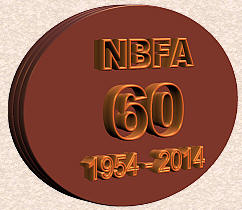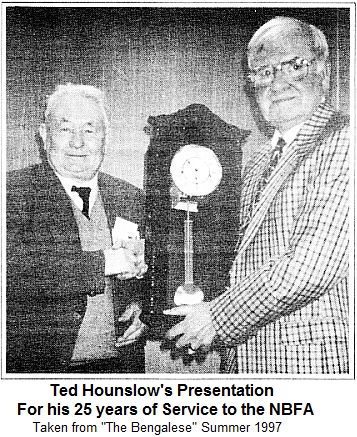

A Brief History of the National Bengalese
Fanciers Association 1954-2014
This brief
history was compiled from the little I could find in my magazines.
NBFA TRIVIA FILE
Taken from the NBFA 40th Anniversary magazine
Compiled by Eric Barlow & Ted Hounslow
The first AGM of the NBFA
took place in 1954 at the National Exhibition of Cage & Aviary Birds ,
Olympia, London. Founder Members were;
W. Bain, P. Dangerfield, Mr. & Mrs. G. Fiveash, H.B.Smith, Mr. &
Mrs. N.
Tolmaer, Mr. & Mrs. S. Wilkinson and Mrs.. Webb.
The first President of
the Association was Sir Godfrey Davis. He resided in Boughton Monchelsea nr
Maidstone Kent. The first Hon. Secretary
was Norman
Tolmaer....
In 1955 the Association
first issued closed coded rings. The first issue was Red followed by Gold
and Violet. They were sold at 3/6d per 10
plus 3d postage.
(17and a half pence per 10 in todays money...)
By 1957 the Association
had a standard show cage. It was designed by G.Fiveash and drawn by W.
Bains, both founder members.
A year book was issued up
to and including 1964, but after that date NBFA publications are something
of a Grey area. The next year book to be
issued were in 1971 and
1972, the last to date. However newsletters and latterly Magazines have been
issued on a regular basis ever since.
During the mid 60's to
the early 70's the Association saw a change in fortune. A state of decline
occurred with constant changes in officers and in some
cases no Officers at all.
During this difficult period John Knowles took the office of Secretary and
kept the Association going through troubled times
In 1972 Ted Hounslow became Hon
Secretary and aided by a succession of Chairman notably Jim Shepherd and Tom
Lockhart, began the process of
revitalizing the
Association.
Regular Committee meetings discussing the sometimes thorny question of Colour Standards and Classifications were held
and at the end of the day
formed the foundation of the General Show and Colour Definitions we have
today.
(When Ted Hounslow had held the post for 25 years he was presented with a
Westminster Chiming Clock
for his services to the NBFA)
1979 marked the Associations 25th Jubilee Year and to celebrate the event
the first ever NBFA All Bengalese Show was held.
The venue was in Bracknell, Berks.
The show was held on Sunday 4th November 1979. The Judges were : W, Gemmell,
T. Hemmings,
E.J. Hounslow and N. Tolmaer. The
response from Members was phenomenal, with members travelling from as far as
Scotland, Wales, Devon
and Essex. The entry was a
magnificent 527 cages.
The judges could not agree on the
overall winner of the show, and so an independent judge was bought in to
decide the outcome. it proved to be winner
for
Mr. & Mrs. N. Cox with a pair of
Chocolate & Whites.
VOICES FROM THE PAST
From THE BENGALESE 1984
by the Late Norman Tolmaer
In the 1920's and early 1930's
Bengalese were always shown in the Class for Mannikins and Munias as a
result they seldom won prizes because they had
to compete with all the other types
of Mannikins and were at a disadvantage for both colour and shape. Most of
them were very small and almost all were
Chocolate and White pieds.
As we still had to show our birds in
the Mannikin classes a few us started to put on our own little shows, just
one or two little classes which we exhibited
wherever we could, as a result
interest in the Bengalese increased until finally enough people were
interested to enable us to form a club of fellow
Bengalese breeders.
So in the Autumn of 1954 about a
dozen of us meet in a cinema in Tooting London to see if we could form a
specialist club devoted to our favorite bird
First we had to think of a name for
the club. This may seem an easy task but first we had to start with the name
of the bird, as at the time it was known as
the Bengellae, the Benglee and the
Bengalese, the name Bengalese was finally accepted. Then a simple schedule
and standard was drawn up.
We then went on to design a show
cage. It was noted there was a tendency to stand one cage on top of another
often with disastrous results, so we
decided to adopt the desk type cage
as used by most foreign exhibitors.
In the 1950's it was common for
fanciers to make their own cages, so we decided all parts of our cage
should be easy to make.
CONTINUING THE 60's WITH BILL BUTTERFIELD
From The London & Southern Bengalese Finch Club 1985
News Letter June 1997
By the Late Bill Butterfield
In the mid
1960's Bengalese were mainly being shown to make up more numbers of birds in
a show, and as such they became somewhat the poor relations
of the show bird world, at about this time
John Knowles gave up the Secretary's position in the NBFA. He had done his
best to keep the NBFA in existence
which was about all it was doing.
At the AGM at Alexandra Palace Norman Cox
was prepared to take on the job as Secretary which he did. He was in office
for a couple of years but nothing
changed, the NBFA still went on it's
negative way, and no new fanciers took interest in Bengalese.
The next Secretary was Ted Hounslow. At the
same AGM he was elected, I asked why did the Bengalese not have the same colour closed rings as the rest of
the bird fancy who used closed rings, we
had the colour which the ring manufacturer nominated for the year. We all
agreed to change this situation by having
the same colours as the rest of the fancy.
The next thing at this same meeting I
pushed the situation of the NBFA not having any panel judges. In true Ted
Hounslow form he said we had no format for
electing judges, so to start off with we
should take those members in attendance who had a reasonable amount of years
keeping Bengalese and these would
be the first panel of judges for the NBFA.
The names I recall are, Norman Tolmaer, Tim Hemmings, Harry Biggs, Eric
Barlow, John Knowles, Ted Hounslow and
myself.
Also at this meeting the Patronage
Secretary resigned and my wife and I took on the job, which also included
gathering the points for publication in future
news sheets.
It was not long before we had a few judges
in Scotland, Willie Gemmel, Jimmy Kidd, Charlie Dick and a few others which
was a step in the right direction.
We still did not have any colour
specification or standards to judge to. I sat down on day in my home and
wrote down my thoughts on what the Bengalese colours
should be. We had Chocolate & Whites,
Fawn & Whites, Self Chocolate, Self Fawn and Self White. All other
colours we
called Dilutes and we had the Crest.
The specifications of colours was published
in a news sheet, produced on a type of duplicating process by Jimmy Kidd who
took on the job as a sort of news editor
When my ideas of colours were read, some of
our fellow fanciers had things to say and some ideas of their own, which was
good. it got something done about
getting the standard to show and judge
to. One thing I wanted was Chocolate & White and Fawn & White to be 50% of
each colour We discussed it and decided
that if we said 50/50 fanciers with birds
that only had a small amount of White feather would not show them and of
course we wanted Bengalese on the show
bench. So we left it that they should be
matched as near as possible.
Self's were being shown with White bibs and
ticks so we changed that. The Self's were of two types , one had flecking and
the other was plainer and all the Self's
were in one class. We did not want to make
too many classes for fear Clubs & Society's would not put Bengalese in their
shows.
Quite a lot of we did for the show
standards and colours still stands today with the test of time.
Having my own business in the early days of
the NBFA was handy because we used my works for the committee meetings,
and this was a good help for the small
funds of the NBFA.
INTO THE 70's WITH BILL BUTTERFIELD
From The London & Southern Bengalese Finch Club 1985
News Letter July 1998
By the late Bill Butterfield
With the NBFA getting's it's act together and more
organised, more people were taking an interest in Bengalese, people like,
Jim Shepherd, Tom Lockhart the
Luxton brothers, Trevor Ottaway, John Fendle and Ted
Rivers to name but a few. Most of them eventually became NBFS panel judges,
obviously I cannot name all
the members here.
What did happen is most clubs and society's seeking NBFA
patronage did not want to engage both a Zebra Finch panel judge and a
Bengalese panel judge.
They wanted one judge who could judge both, so we had
Zebra Finch judges joining the NBFA and taking on Bengalese breeding , some
took a real interest in
Bengalese, while others I suspected just wanted to get
on the NBFA panel. In retrospect this was probably a good thing for the
Bengalese, helping it on it's way to
were it is today in it's own right.
Ted Hounslow continued to be the NBFA Secretary
throughout the 70's. Jim Shepherd and Tom Lockhart were Chairmen during
these years, and the AGM was still
being held at the National Exhibition in Alexandra
Palace.
We still held our meetings at my place of business and
a few times we all met at Harry Biggs home. We still had to watch the
finances of the NBFA, but always managed
to pay our way and never get into any debt.
An interesting Fact from the 1980/81 handbook. "The Committee has now
accepted the Chestnut as a separate mutation"
At the 2002 National Exhibition The NBFA launched their publication "The
Bengalese" it has had worldwide sales.

NBFA President Willie Gemmell made the presentation
Ted Hounslow on the Left
in the picture



